The Economics and Statistics Division maintains archives of previous publications for accountability purposes, but makes no updates to keep these documents current with the latest data revisions from Statistics Canada. As a result, information in older documents may not be accurate. Please exercise caution when referring to older documents. For the latest information and historical data, please contact the individual listed to the right.
<--- Return to Archive
For additional information relating to this article, please contact:
September 14, 2023HOUSING ECONOMIC ACCOUNTS, 2022 [CORRECTED] Statistics Canada has released corrected data for the housing economic accounts for all years, 1961-2022. The original published data from August 21, 2023 is incorrect. This article has been updated based on the corrected data.
Statistics Canada has released housing economic accounts (HEA) for 2022, which isolate the role and impact of housing in Canada and the provinces. It provides a macroeconomic perspective on housing assets that represent the physical structures and supported services in residential real estate. The HEA includes investment and net stock by industry and type of housing.
On a per capita basis, the residential net asset stock was valued at $72,067 in Nova Scotia at the end of 2022. Nationally, the residential net stock was worth $96,381 per person with the highest value in Ontario and lowest in Prince Edward Island. Nova Scotia's private housing net stock was $70,774 per person and social housing was $1,293 per person. Nationally, private residential net stock was $94,123 per person and social housing net stock was $2,258 per person. Ontario had the highest private net stock per capita while the lowest was in Prince Edward Island. Social housing net stock per capita was highest in Manitoba and lowest in Prince Edward Island.
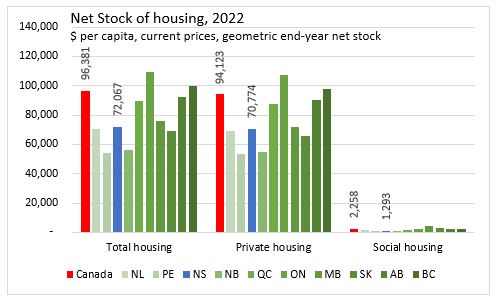
The per capita value of single-detached houses was $43,203 in Nova Scotia and $51,834 in Canada at the end of 2022. Single-detached houses had the highest net stock per capita in every province. Ontario had the highest single-detached house per capita value while in Prince Edward Island it was the lowest. The net stock per capita of row house is notable higher in Ontario than other provinces. The net stock per capita of apartments was $20,982 in Nova Scotia and $28,423 in Canada. British Columbia, Quebec, and Ontario had highest value in apartment net stocks per capita. Nova Scotia's apartment net stock per capita is higher than other Atlantic provinces, Manitoba, Saskatchewan and Alberta.
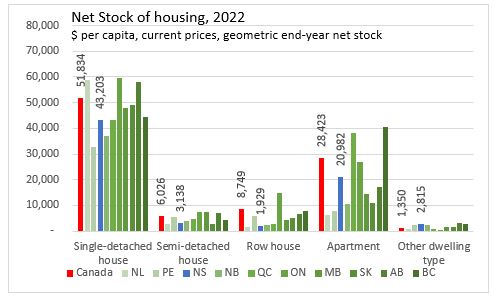
By economic sector, households ($70,083 per person) account for most of the residential net stock. Outside households, the net stock per capita in Nova Scotia is with non-financial corporations ($582 per person), financial corporations ($110 per person), government ($798 per person), and non-profit institutions serving households ($494 per person).
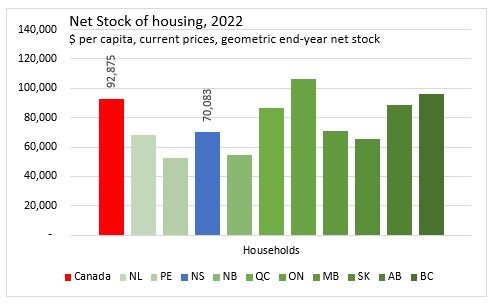

The value of the residential net stock can also be divided into sources of spending based on new construction, renovations, or ownership transfer. On a per capita basis, Nova Scotia net stock from new construction was $47,055 while $24,934 came from renovations and $77 from ownership transfer costs. Ontario, British Columbia, Quebec, and Alberta had the highest new construction net stock per capita while the lowest was in Prince Edward Island and New Brunswick. Renovation net stock per capita was highest in British Columbia and Ontario and lowest in Prince Edward Island and New Brunswick.
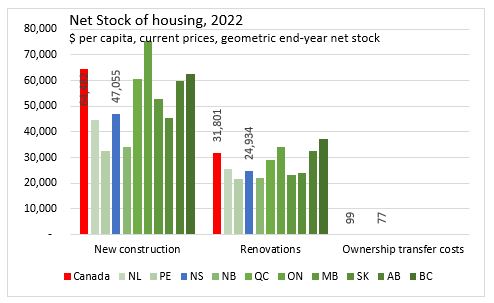
The average age of Nova Scotia's residential assets has made a modest decline from 17.3 years in 2018 to 17.1 years in 2022. Nationally, residential assets are 17.0 years with the youngest stock in British Columbia and Prince Edward Island and the oldest in Newfoundland and Labrador.
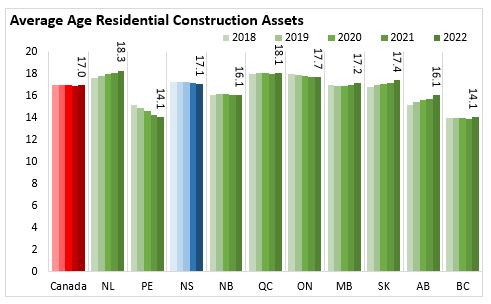
The remaining useful service life ratio is the percentage of time an asset has before being fully depreciated. In Nova Scotia, residential assets had 58.7% remaining useful service life, below national 59.3%. Residential assets in Newfoundland and Labrador had the lowest ratio while British Columbia had the most remaining useful service life.
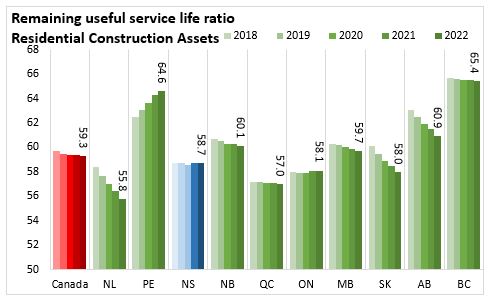
The average age of single-detached houses was 18.7 years in Nova Scotia, above national average of 18.3 years. Prince Edward Island had the lowest average age for single-detached houses. The average age for semi-detached house and row houses were lower in Nova Scotia than Canada. The average age of apartment was 13.9 years in Nova Scotia, above the national average of 13.4 years.
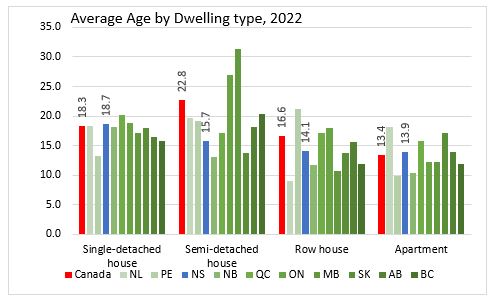
Among housing types in Nova Scotia, single detached houses had the least remaining service at 55.5% while apartments had the most at 65.7%.
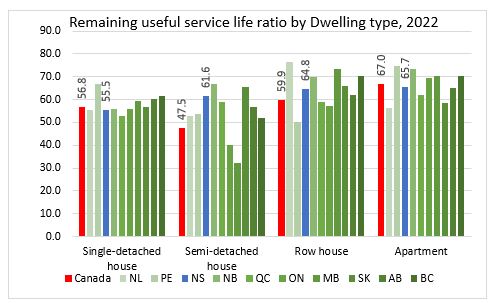
Source:
Statistics Canada. Table 36-10-0677-01 Housing Economic Account, investment, depreciation and net stock by asset, sector, dwelling type, and housing type (x 1,000,000)
Statistics Canada. Table 36-10-0680-01 Housing Economic Account, average age measures, by asset and dwelling type
<--- Return to Archive